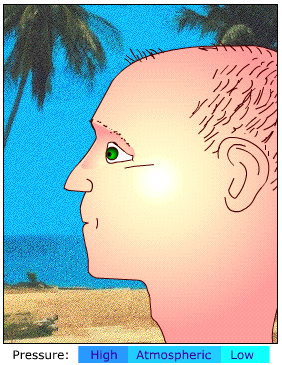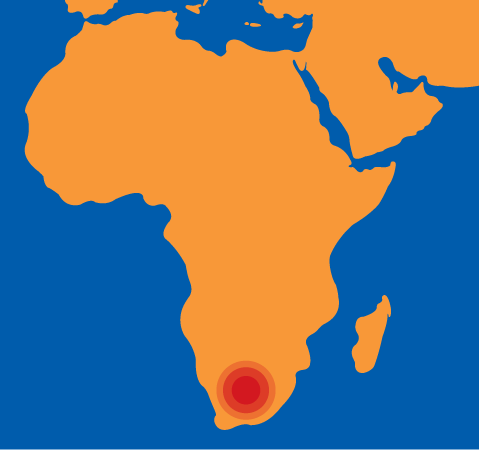 Velaric refers to another kind of airflow that is generated just within the oral cavity, and which doesn’t involve pulmonic airflow coming from the lungs. Instead it uses suction to create differentials in air pressure. Here’s how it works:
Velaric refers to another kind of airflow that is generated just within the oral cavity, and which doesn’t involve pulmonic airflow coming from the lungs. Instead it uses suction to create differentials in air pressure. Here’s how it works:
If you seal off air within some space, then increase the volume of that space – then the air pressure inside that space will decrease, and be less than the atmospheric pressure outside. If you then break the seal, air rushes in to equalise the pressure. The sudden equalisation of air pressure makes a short sharp noise.
The speech sounds made with this type of airstream are what we know as ‘clicks’.
There are two main ways that clicks can be formed: one seals the entire oral cavity, the other traps a small pocket of air against the roof of the mouth. We’ll call these ‘lip clicks’ and ‘tongue clicks’. Scroll down to explore each type separately.
lip click
To produce a lip click;
- create a sealed chamber by closing your glottis, velurn and your lips. Your oral cavity is now a completely sealed air pocket.
- By lowering your jaw slightly you can increase the volume of the oral cavity, and this causes the air pressure in it to drop.
- Now when you release your lip contact, air rushes into your mouth to equalise pressure. If this sounds complicated, it’s exactly what you do when you make a no contact ‘air kiss’.
Play the animation to see these steps, and hear the sound.
Now, you try making a lip click, concentrating on the sensations of closing your glottis and lips, and feeling the slight muscular effort involved in enlarging the oral cavity just before you release your lips.
tongue click 1: the ‘giddy-up’ click
Clicks can also be produced by sealing off a small pocket of air between the tongue and the palate. Try these steps:
- Raise both the back of the tongue to the velum, and the tip of the tongue to just behind the alveolar ridge. Feel the sides of the tongue also making contact with your palate and cheeks. You now have a small pocket of air trapped in a sealed chamber.
- Now pull the body of your tongue down, while maintaining tongue contact around the edges. You’ll feel the decreased air pressure in the trapped pocket of air as suction on the roof of your mouth.
- Pull down the sides of your tongue, breaking the seal. The short sharp click you produce is the sound of air rushing into the chamber you depressurised, equalising the air pressure.
English speakers use this ‘giddy-up’ click to get a horse to move, etc. Technically, its a post-alveolar click with lateral release (ie. it is the sides of the tongue, not the tip, that break the seal).
Play the animation to see these steps, and hear the sound. Note the position of the trapped air pocket, as on the next screen we’ll contrast this with another click sound that is familiar to you.
Practise this click while breathing in and out and feel how its production is quite independent of pulmonary airflow.
tongue click 2: the ‘tsk tsk’ click
It is possible to produce different tongue clicks because;
- We can move the tongue backwards and forwards within the mouth, making clicks at different places on the palate.
- We can also break the seal in different ways, creating different sounding clicks.
The second tongue click that English speakers use demonstrates these differences.
The ‘disapproval’ click (usually written as ‘tsk tsk’ or ‘tut tut’) is produced with the tongue tip further forward, in contact with the back of the teeth. A small pocket of air is trapped below the alveolar ridge. This click is released by pulling the tongue tip down. Technically, it is known as a dental click.
Play the animation to see this, and listen to the sound. Note the position of the trapped air pocket just behind the teeth.
Imagine these English clicks as speech sounds
Of course the English ‘tsk tsk’ and ‘giddyup’ clicks are not speech sounds. However it is not hard to imagine that these sounds could be regular consonant phonemes, and combine with vowels in forming words. Try putting each of these familiar click sounds into the frame of vowels [ɐ_ɐ]. Play the audio below – then try it for yourself!
The giddyup click ([ǃ] (post)alveolar click)
The tsk tsk click ([ǀ] dental click)

clicks as speech sounds
About 1% of the world’s languages have click sounds functioning as consonants. The densest clustering of click languages is found in Southern Africa, as shown on the map. In these languages clicks function as a manner-of-articulation category, just like stops and fricatives etc., and they combine with vowels and other consonants to form words.
Many languages with clicks have them at several places of articulation. Clicks can also be released in different ways, or aspirated, or nasalised. The language !Xu has 48 phonemic clicks!
The International Phonetic Alphabet (revised 1989) provides these symbols for clicks at 5 different places of articulation:
ʘ bilabial click
ǀ dental click
ǃ (post)alveolar click
ǂ palato-alveolar click
ǁ alveolar lateral click
Play the movie to hear Rosetta say the sentence below in Sesotho, spoken in South Africa and Lesotho. Sesotho has a click at just one place-of-articulation, the palato-alveolar click [ǂ], which is written as ‘q’. This click can also be aspirated, and written as ‘qh’. The ‘tl’ is an ejective (or glottalic) alveolar lateral affricate.
Ke tla o qoqela moqoqo o qalang leqepheng la ho qetela.
I will you tell story that starts page that is last
‘I’m going to tell you the story that starts on the last page’.